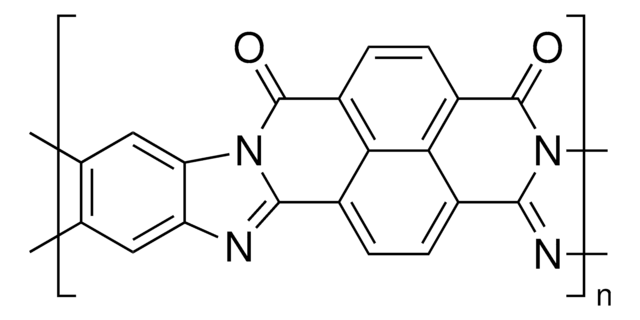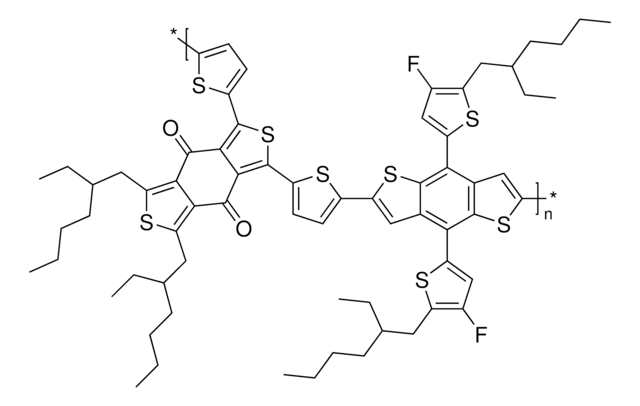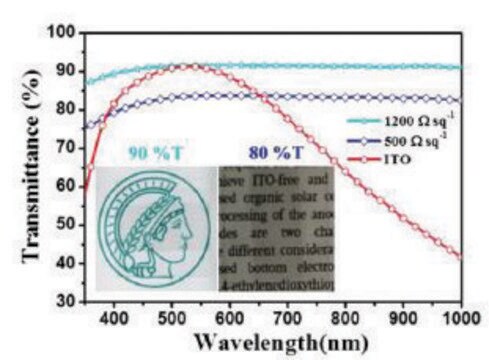932647
n-Type BBL:PEI ink
butanol-based
Synonyme(s) :
Poly(benzimidazobenzophenanthroline) polyethylenimine butanol ink, n-ink-40-1-B
About This Item
Produits recommandés
Description
Thermal stability (1h in N2): Up to 350 °C
Niveau de qualité
Composition
butanol (solvent)
Travail d'extraction
4.22 eV, UPS analysis
Conductivité
((in plane): Up to 5 S/cm)
((out of plane): Up to 0.1 S/cm)
λmax
350 nm±5 nm
600 nm±5 nm
Application
It is compatible with large scale deposition methods, such as spray-coating and inkjet. The BBL:PEI ink can be further diluted for casting thin films in various thickness. BBL:PEI thin films were fabricated by spray-casting in air, followed by annealing at 140 °C for 2 h inside a nitrogen-filled glovebox or under vacuum to produce conducting films. The BBL:PEI ink, when processed, forms a high electron conducting n-type film that can be implemented as conducting layer in solar cells, thermoelectric generators, light-emitting diodes, or logic applications:
- OPV – Charge extracting layer in Organic Solar Cells
- SuperCapacitors – Negatrode in Organic Supercapacitors
- OECT – Active material in Organic Electrochemical Transistors
- OLED – Charge injecting layer in Organic Light Emitting Diodes
Notes préparatoires
- Always store the ink in dark and at ambient temperature.
- Shake the bottle vigorously to ensure an optimal dispersion of the ink prior to processing (by using ultrasonic bath for instance; 100 to 300 W for 30 min).
- The ink is primarily designed to be spray-casted, with an air-gun or similar spraying methods.
- The films are stable in air up to 2 days before its thermal activation.
- Always proceed with the thermal activation of ink under inert environments (vacuum, N2, Ar, etc.) or if properly encapsulated with an air-stable compound.
- Thermally activated films of our ink films are not affected by chloroform, chlorobenzene, 1,8-diiodooctane, dimethylformamide and dimethyl sulfoxide.
Mention d'avertissement
Danger
Mentions de danger
Conseils de prudence
Classification des risques
Acute Tox. 4 Oral - Eye Dam. 1 - Flam. Liq. 3 - Skin Irrit. 2 - Skin Sens. 1 - STOT SE 3
Organes cibles
Central nervous system, Respiratory system
Code de la classe de stockage
3 - Flammable liquids
Classe de danger pour l'eau (WGK)
WGK 2
Point d'éclair (°F)
95.0 °F
Point d'éclair (°C)
35 °C
Faites votre choix parmi les versions les plus récentes :
Certificats d'analyse (COA)
Désolés, nous n'avons pas de COA pour ce produit disponible en ligne pour le moment.
Si vous avez besoin d'assistance, veuillez contacter Service Clients
Déjà en possession de ce produit ?
Retrouvez la documentation relative aux produits que vous avez récemment achetés dans la Bibliothèque de documents.
Notre équipe de scientifiques dispose d'une expérience dans tous les secteurs de la recherche, notamment en sciences de la vie, science des matériaux, synthèse chimique, chromatographie, analyse et dans de nombreux autres domaines..
Contacter notre Service technique



![Poly[(9,9-di-n-octylfluorenyl-2,7-diyl)-alt-(benzo[2,1,3]thiadiazol-4,8-diyl)] average Mn ≤25000](/deepweb/assets/sigmaaldrich/product/structures/428/661/1c4ebb98-9d51-48c0-96c7-e556ca425aa4/640/1c4ebb98-9d51-48c0-96c7-e556ca425aa4.png)


![[6,6]-Phenyl C61 butyric acid methyl ester ≥99%](/deepweb/assets/sigmaaldrich/product/structures/359/221/d990c746-0960-4c69-bf76-fe09b193824d/640/d990c746-0960-4c69-bf76-fe09b193824d.png)




